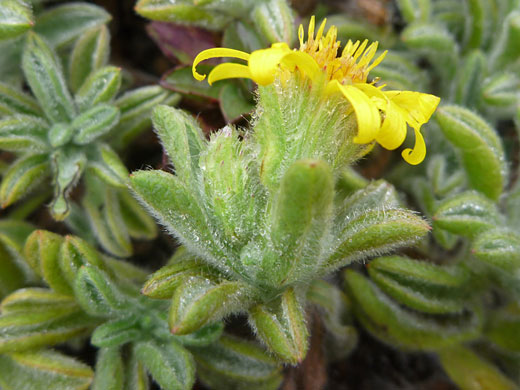Heterotheca Sessiliflora, Sessileflower False Goldenaster
Plants > Wildflowers > Asteraceae > Heterotheca Sessiliflora

Heterotheca sessiliflora ssp bolanderi in Point Cabrillo Light Station State Historic Park, California
Common name:
Sessileflower false goldenaster
Family:
Scientific name:
Heterotheca sessiliflora
Main flower color:
Range:
California, mostly towards the west
Height:
Usually up to 2 feet; sometimes higher
Habitat:
Coastal bluffs, dunes, woodland, hillsides, up to 7,200 feet
Leaves:
Oblanceolate to lanceolate, glandular hairy
Season:
June to October
Heterotheca sessiliflora is a variable plant, with four subspecies, inhabiting a range of different environments. The genus name refers to the flowers, which form directly at the upper leaf node, without a recognizable stalk (sessile). Stems grow upwards or sideways, branch freely, and, like the leaves, have a covering of long, bristly, glandular hairs. Leaves also lack stalks, are densely hairy, and are often folded up along the axis.
Plants produce many flowerheads; these are formed of between 4 and 24 yellow ray florets, half an inch or less in length, and 20 to 50 yellow disc florets, the lobes of which have a thin hair covering. The narrow green phyllaries are in four to six rows, and they are also hairy.
The four subspecies (bolanderi, sessiliflora, echioides, fastigiata) are distinguished by leaf margins, stem hairiness, leaf shape and presence/absence of leafy bracts beneath the flowerhead. The first two are coastal subspecies, while the latter two are found inland, up to 7,000 feet elevation.
Plants produce many flowerheads; these are formed of between 4 and 24 yellow ray florets, half an inch or less in length, and 20 to 50 yellow disc florets, the lobes of which have a thin hair covering. The narrow green phyllaries are in four to six rows, and they are also hairy.
The four subspecies (bolanderi, sessiliflora, echioides, fastigiata) are distinguished by leaf margins, stem hairiness, leaf shape and presence/absence of leafy bracts beneath the flowerhead. The first two are coastal subspecies, while the latter two are found inland, up to 7,000 feet elevation.
All Contents © Copyright The American Southwest | Comments and Questions | Contribute | Site Map



